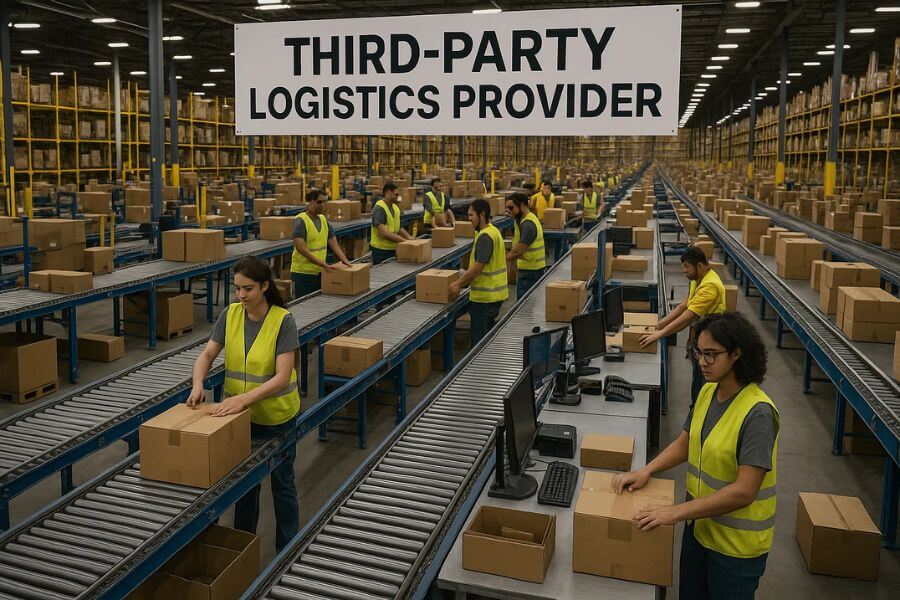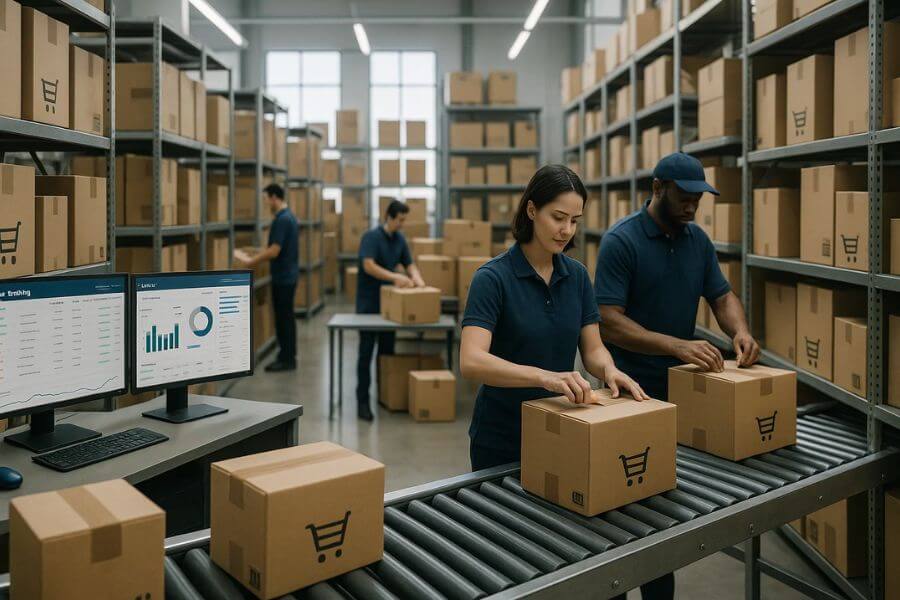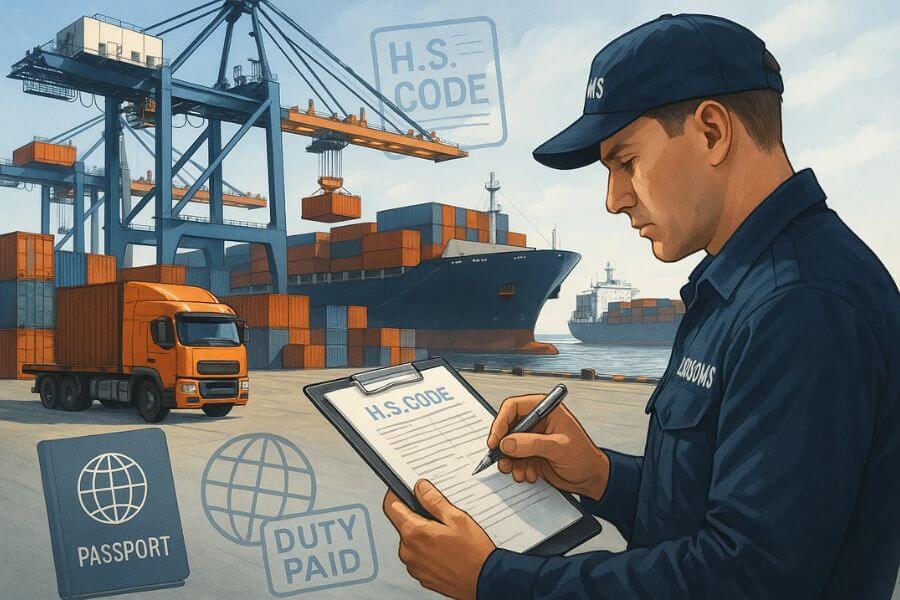In the fast-evolving world of ecommerce, fulfillment plays a pivotal role in ensuring that customers receive their orders promptly, accurately, and in great condition. As a beginner, understanding the concept of in-house fulfillment and how it can work for your business is essential for streamlining operations, enhancing customer satisfaction, and controlling costs. This ultimate guide will take you through the basics of in-house fulfillment, step-by-step instructions for managing it, its benefits, challenges, and how to decide when it’s time to scale your business by outsourcing to a third-party logistics (3PL) provider.
What is in-house fulfillment?

In-house fulfillment is the process in which an eCommerce business handles the entire fulfillment cycle internally. This includes everything from storing inventory, picking and packing items when an order comes in, to shipping them out directly to the customer. Unlike outsourcing fulfillment to a 3PL provider, where external companies manage the logistics, in-house fulfillment gives you more control over your operations, allowing you to manage every aspect personally.
For smaller businesses or entrepreneurs just starting out, in-house fulfillment can be an attractive choice because it offers lower overhead costs, direct inventory oversight, and the flexibility to provide a more personalized experience for customers. As your business expands, however, in-house fulfillment may become challenging to scale, requiring additional resources and labor to meet demand.
What are the key steps in in-house fulfillment?

Understanding and mastering the key stages of in-house fulfillment will be crucial to running an efficient and profitable operation. Below, we walk through the necessary steps involved in handling fulfillment for your ecommerce store:
1. Inventory management
Effective inventory management is the foundation of successful in-house fulfillment. Whether you’re selling physical products or digital goods, keeping track of your stock ensures that you don’t run into issues like stockouts or excess inventory that leads to overstocking.
Managing your inventory includes receiving new stock, organizing products in storage, and making sure everything is logged into your system. Many ecommerce businesses utilize specialized inventory management software that helps track stock levels, sends alerts when products are running low, and generates detailed reports.
Inventory management tips:
- Use an inventory management system (IMS) that integrates seamlessly with your ecommerce platform.
- Implement barcodes or RFID tags for easy product tracking.
- Schedule regular audits to ensure inventory levels are accurate and up to date.
2. Order receiving and sorting
Once a customer places an order on your website, you’ll need to receive the order details, confirm the items are in stock, and sort them for fulfillment. This step is especially important to avoid mistakes when dealing with multiple orders at once.
You can sort orders by product category, shipping method, or urgency. In a larger operation, you may need to segment orders to ensure timely processing. The goal here is to prioritize and organize orders in a way that minimizes errors and ensures fast processing.
Tips for sorting orders:
- Set up clear processes for categorizing and sorting orders to improve workflow efficiency.
- Ensure orders are processed on a first-come, first-served basis to meet delivery deadlines.
- Use an order management system (OMS) to automate the receiving and sorting process.
3. Picking and packing
Picking involves retrieving the right products from your inventory, while packing ensures they’re securely prepared for shipping. Depending on the size of your business, picking can either be a manual or automated process.
For small-scale operations, the process may involve a team member physically going to the shelves and retrieving the correct items, while in larger operations, conveyor belts, pick-to-light systems, or robotics might be used to streamline this process.
Packing should be done carefully to protect items during shipment. The right materials (boxes, bubble wrap, packing peanuts) are essential to preventing damage, especially for fragile products.
Packing tips:
- Use appropriately sized boxes to prevent items from shifting during shipping.
- Invest in protective packaging materials to safeguard delicate products.
- Consider eco-friendly packaging to appeal to sustainability-conscious customers.
4. Shipping
Shipping is the final stage in the fulfillment process. Once an order is packed, it needs to be sent to the customer as quickly and cost-effectively as possible. Selecting the best shipping carrier and method is vital to meet customer expectations and minimize costs.
Depending on the destination and order size, you may choose different shipping options. Offering expedited shipping can increase customer satisfaction, while providing standard or economy options can reduce costs. Don’t forget to include tracking information in the order confirmation email so customers can monitor their shipments.
Shipping tips:
- Compare rates across various carriers to find the most cost-effective options.
- Offer multiple shipping choices, including express shipping for faster delivery.
- Use shipping software that integrates with your ecommerce store to manage shipping labels and tracking information efficiently.
5. Order tracking and customer service
Order tracking is a critical part of the fulfillment process. Once the order is shipped, customers expect to know when their package will arrive. Providing tracking information via email or text can help enhance the customer experience.
Additionally, effective customer service is essential in the event that issues arise, such as delivery delays or incorrect items being shipped. A smooth process for handling returns and customer inquiries is vital to retaining customers and building a positive reputation for your brand.
Customer service tips:
- Set up an automated email system to notify customers when their order ships and provide tracking information.
- Invest in customer service software to manage inquiries efficiently.
- Have a clear and fair return policy in place to handle returns and exchanges.
What are the benefits of in-house fulfillment?

Running your fulfillment operations internally offers several benefits, particularly for small businesses. Here are some of the main advantages:
1. Complete control over inventory
With in-house fulfillment, you have direct oversight of your inventory at all times. This gives you the flexibility to quickly identify and address stock issues, such as missing or damaged products. It also ensures you have the ability to provide faster restocking and accurate order fulfillment.
2. Customization and personalization
When you handle fulfillment yourself, you can offer more personalized experiences for your customers. For example, you can include handwritten thank-you notes, custom packaging, or exclusive samples that make customers feel special. Personalization can help you create a memorable experience that encourages customer loyalty.
3. Cost savings
For many small businesses, in-house fulfillment can save money on third-party logistics (3PL) fees. You don’t have to pay for storage, packing, and shipping services from external providers, which can add up quickly. By handling everything in-house, you keep your costs low, especially when you are in the early stages of growing your business.
4. Faster fulfillment times
In-house fulfillment typically leads to quicker processing times, especially when compared to relying on 3PL providers who may have to juggle multiple clients’ orders. Because your inventory and packing stations are right under your roof, you can expedite order fulfillment and offer faster shipping to customers.
5. Easy return management
Managing returns can be a hassle, but when you handle fulfillment in-house, it becomes much easier to process returns efficiently. You can inspect returned items, restock them if needed, and immediately take action to rectify any problems that might arise.
What are the challenges of in-house fulfillment?

While in-house fulfillment has its perks, it’s not without its challenges. Here are some of the obstacles to consider before deciding whether to handle fulfillment on your own:
1. Space limitations
As your inventory grows, you may run out of storage space. Managing a warehouse or storage facility can become costly, especially in areas with high rent. You’ll need to continually reassess your space requirements as your business scales.
2. Labor costs
Handling fulfillment in-house requires time and effort, which often translates into higher labor costs. As your order volume increases, you’ll need to hire more staff or work longer hours to meet demand. This can quickly add up and might limit profitability, especially if you’re not ready for the added expense.
3. Shipping and logistics complexity
Shipping can become complicated, especially when fulfilling orders to international customers or dealing with complex shipping scenarios (e.g., fragile or oversized products). Managing these logistics internally requires expertise in international shipping regulations, customs duties, and selecting the best shipping partners.
4. Risk of human error
In-house fulfillment often involves manual processes, which increases the risk of errors. Mistakes in picking, packing, or shipping orders can lead to customer complaints, increased returns, and wasted resources. Ensuring that all staff members are well-trained is crucial to reducing errors and keeping fulfillment smooth.
When should you transition from in-house fulfillment to outsourcing?

As your business grows, you may face challenges in scaling your in-house fulfillment operation. If you’re reaching a point where in-house fulfillment is no longer sustainable, it may be time to consider outsourcing to a 3PL provider.
Signs you may need to outsource include:
- Your storage space is running out and you need a larger warehouse.
- Order volume is overwhelming and you can’t keep up.
- Shipping costs and logistics management have become too complex.
- You need specialized services that a 3PL can provide.
Conclusion
In-house fulfillment can be an excellent way for small eCommerce businesses to gain control over their operations, minimize costs, and provide personalized experiences for their customers. However, as your business expands, you must assess whether you can continue fulfilling orders in-house or whether outsourcing fulfillment to a 3PL provider is more viable. By mastering the ins and outs of in-house fulfillment, you’ll be better prepared for growth, offering exceptional service to your customers every step of the way.
If you reach the point where in-house fulfillment no longer meets your needs, outsourcing to a 3PL can help you scale your operations efficiently and reduce the strain on your resources. Until then, continue refining your in-house fulfillment processes to ensure the success of your ecommerce business.
Frequently asked questions about in-house fulfillment
In-house fulfillment can be a complex process for beginners. Below are answers to some of the most common questions businesses have when considering managing their own fulfillment:
Q1. What is the difference between in-house fulfillment and third-party logistics (3PL)?
A1. In-house fulfillment means that you handle every aspect of order fulfillment internally—inventory management, picking, packing, and shipping—within your own warehouse or storage space. In contrast, 3PL refers to outsourcing all or part of the fulfillment process to an external service provider that specializes in logistics, allowing you to focus on other aspects of your business.
Q2. Can I scale in-house fulfillment as my business grows?
A2. Yes, but scaling in-house fulfillment requires careful planning. As your order volume increases, you’ll need to invest in more storage space, hire additional staff, and enhance your systems for inventory management and order processing. It’s essential to continuously monitor your capacity to handle more orders efficiently and consider automation or software tools to streamline operations.
Q3. Do I need special software for in-house fulfillment?
A3. While it’s not strictly necessary, using fulfillment software or an integrated system can greatly enhance your efficiency. Inventory management systems (IMS), order management systems (OMS), and shipping software can automate tasks, provide real-time tracking, and reduce human error. As your business grows, the right software can save you time and ensure smooth operations.
Q4. How can I handle returns in in-house fulfillment?
A4. Handling returns is an essential part of in-house fulfillment. For smooth returns management, establish a clear return policy and process. Set up a dedicated space in your warehouse for returned items, inspect them to determine if they can be restocked, and then update your inventory records accordingly. Offering hassle-free returns will improve customer satisfaction and loyalty.
Q5. What are the costs associated with in-house fulfillment?
A5. The costs of in-house fulfillment can vary depending on your business size and needs. Key expenses include:
- Storage space (renting a warehouse or storage facility)
- Labor costs (for picking, packing, and shipping)
- Packaging materials
- Shipping costs (postage and carrier fees)
- Inventory management software or fulfillment tools
Although in-house fulfillment can be cost-effective for small businesses, these costs increase as your business scales.
Summary
In ecommerce, In-House Fulfillment refers to the process where a business manages all aspects of order fulfillment, including inventory management, picking, packing, and shipping, within its own facilities instead of outsourcing to a third-party logistics provider.





